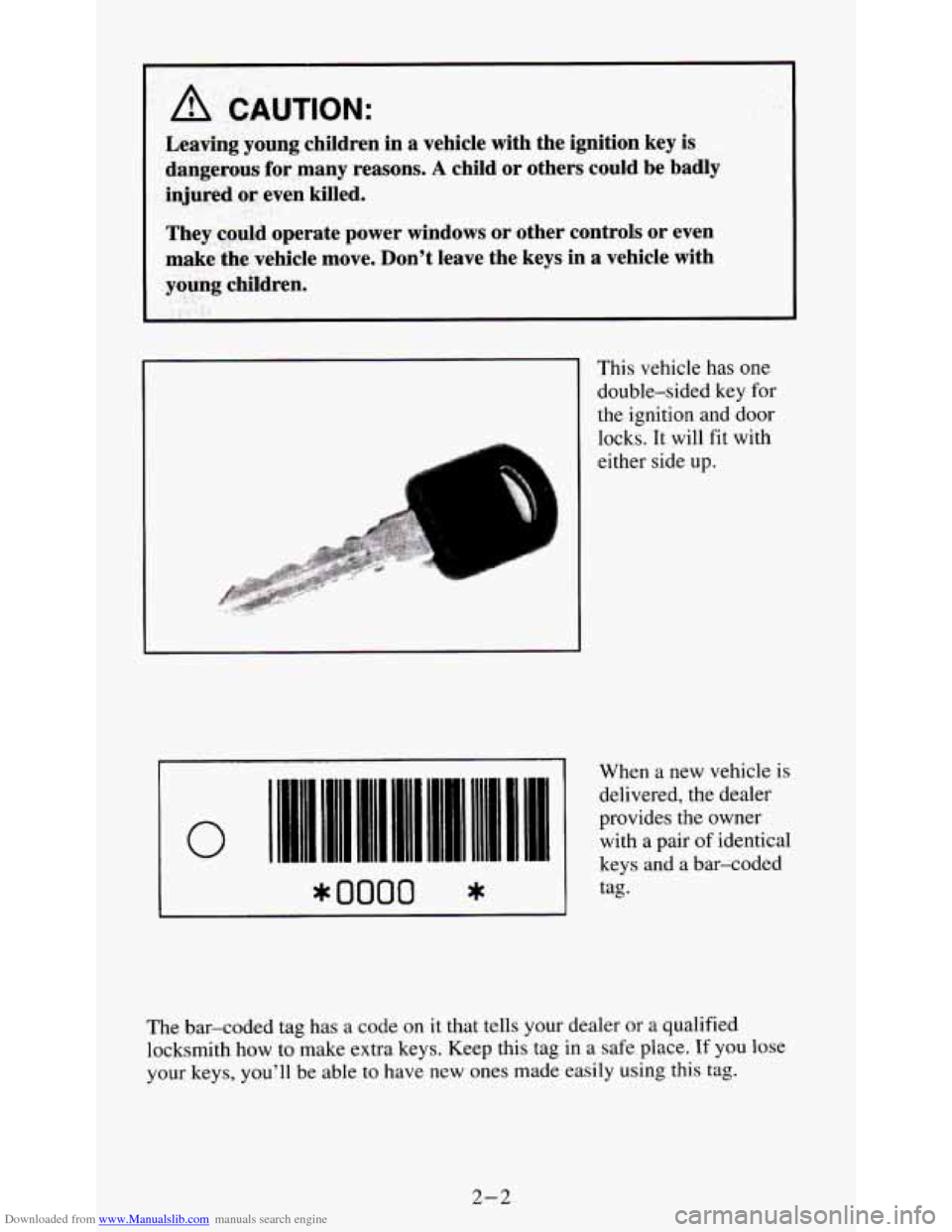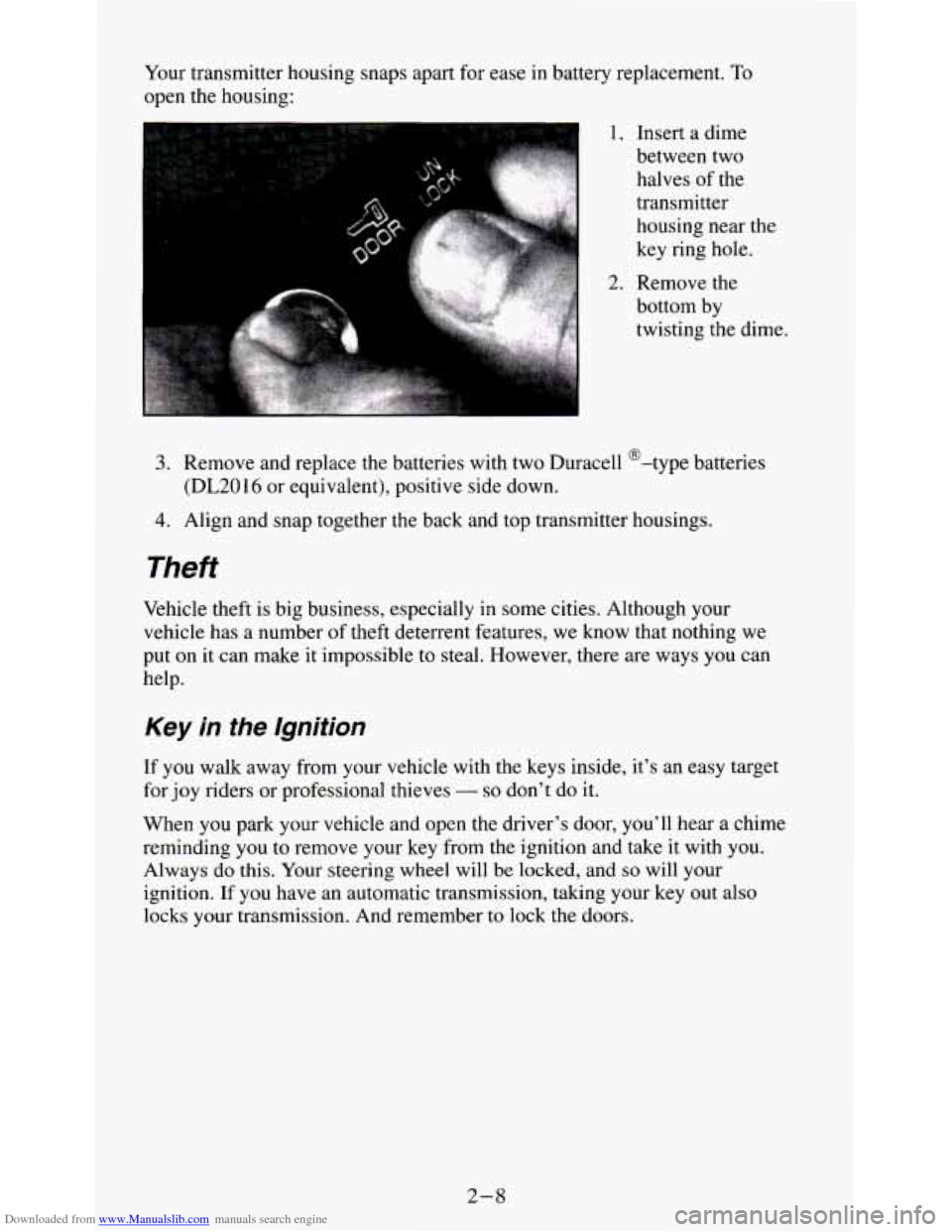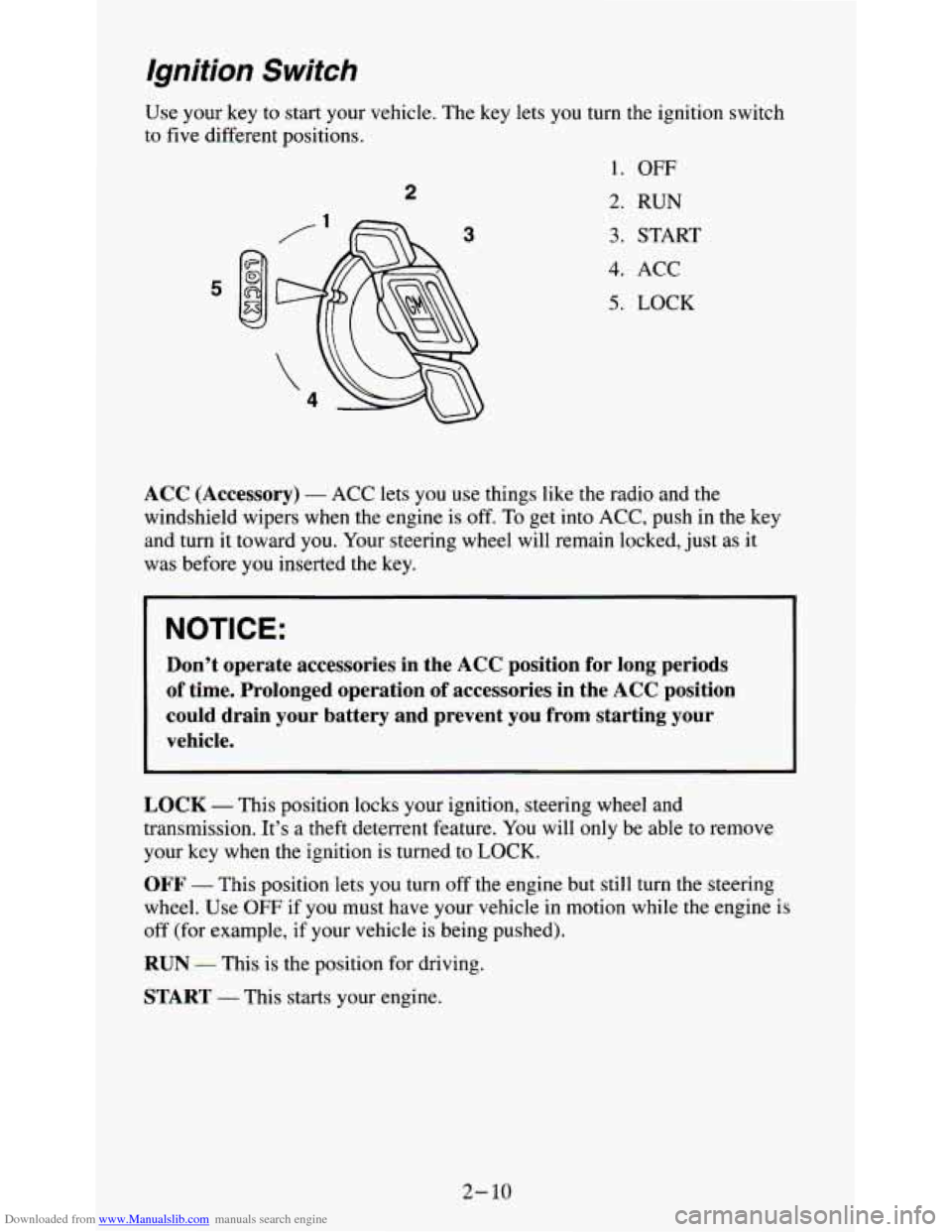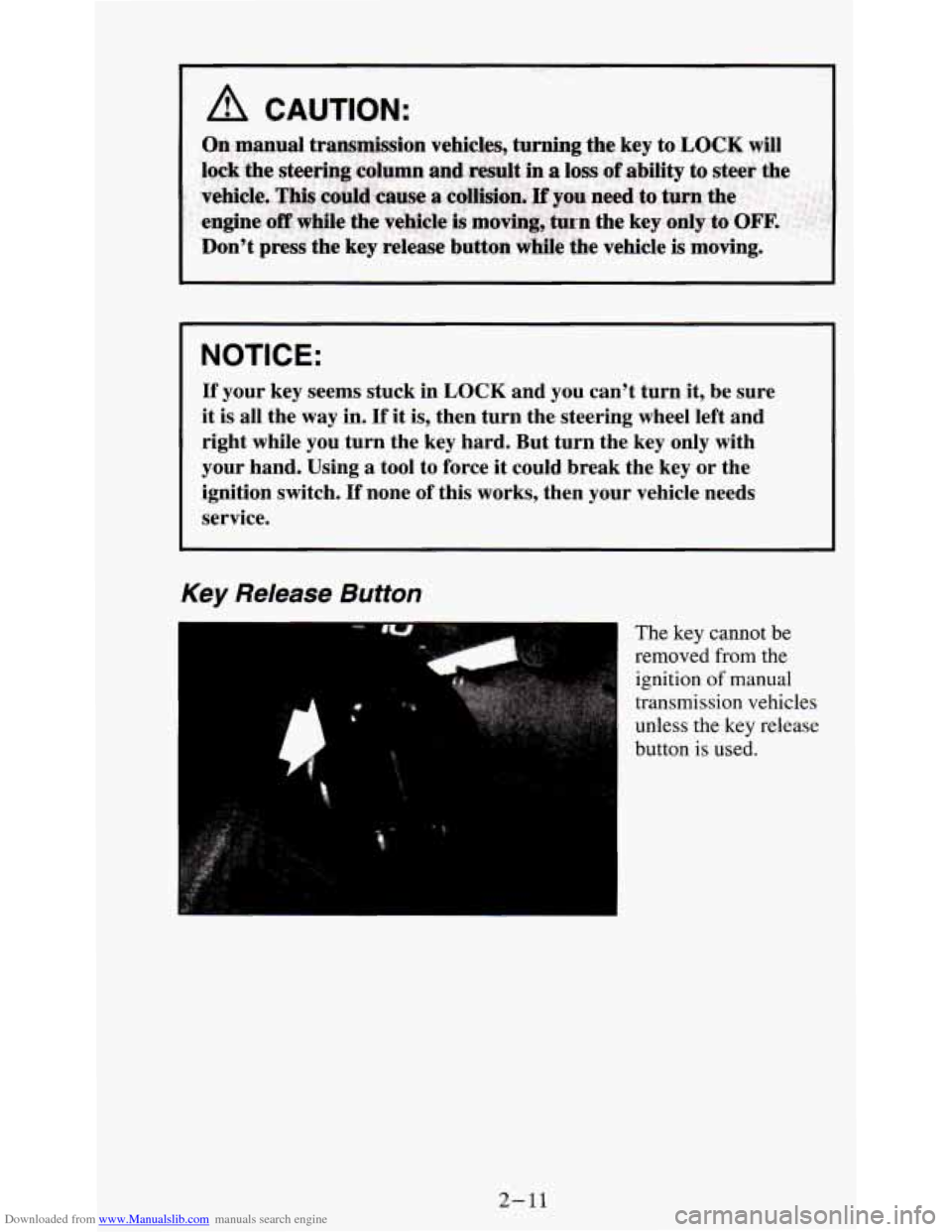1995 CHEVROLET S10 ignition
[x] Cancel search: ignitionPage 29 of 354

Downloaded from www.Manualslib.com manuals search engine Your vehicle is equipped with a diagnostic module, which records
information about the air bag system. The module records information
about the readiness
of the system, when the sensors are activated and
driver’s safety belt usage at deployment.
Let only qualified technicians work on your air bag system. Improper
service can mean that your air bag system won’t work properly. See
your dealer for service.
NOTICE:
If you damage the cover for the driver’s air bag, it may not work
properly. You may have to replace the air bag module.
Do not
open or break the air bag cover.
Servicing Your Air Bag-Equipped Vehicle
The air bag affects how your vehicle should be serviced. There are parts of
the air
bag system in several places around your vehicle. You don’t want the
system to inflate while someone is working
on your vehicle. Your GM
dealer and the
1995 GM Service Manual have information about servicing
your vehicle and the air bag system. To purchase a service manual, see
“Service Publications” in the Index. The air bag system does not need
regular maintenance.
I A CAUTION:
For up to 2 minutes after the ignition key is turned off and the
battery
is disconnected, an air bag can still inflate during
improper service. You can be injured
if you are close to an air
bag when,it inflates. Avoid wires wrapped with yellow tape, or
yellow connectors. They are probably part
of the air bag system.
Be sure to follow proper service procedures, and make sure the
person performing work for you is qualified to do
so.
1-20
Page 47 of 354

Downloaded from www.Manualslib.com manuals search engine A CAUTION:
Leaving young children in a vehicle with the ignition key is
dangerous for many reasons.
A child or others could be badly
injured
or even killed.
They could operate power windows or other controls or even
make the vehicle move. Don’t leave the keys in a vehicle w\
ith
young children.
This vehicle has one
double-sided key for
the ignition and door
locks. It will fit with
either side up.
iIIII Ill1
FMllM 11111 1111I 11111 IllUl 111111 II I1
I
When a new vehicle is
delivered, the dealer
provides the owner
with a pair of identical
keys and a bar-coded
0 11111 11111 11.11 .1..1 ,1111. .... I. I. .-
* 0000 *
The bar-coded tag has a code on it that tells your dealer or a qualified
locksmith how to make extra keys. Keep this tag
in a safe place. If you lose
your keys,
you’ll be able to have new ones made easily using this tag.
2-2
Page 53 of 354

Downloaded from www.Manualslib.com manuals search engine Your transmitter housing snaps apart for ease in battery replacement. To
open the housing:
1. Insert a dime
between two
halves
of the
transmitter
housing near the
key ring hole.
2. Remove the
bottom by
twisting the dime.
3. Remove and replace the batteries with two Duracell @-type batteries
4. Align and snap together the back and top transmitter housings.
(DL2016
or equivalent), positive side down.
Theft
Vehicle theft is big business, especially in some cities. Although your
vehicle has a number
of theft deterrent features, we know that nothing we
put
on it can make it impossible to steal. However, there are ways you can
help.
Key in the lgnition
If you walk away from your vehicle with the keys inside, it’s an easy target
for joy riders or professional thieves
- so don’t do it.
When
you park your vehicle and open the driver’s door, you’ll hear a chime
reminding you
to remove your key from the ignition and take it with you.
Always do this. Your steering wheel will be locked, and so will your
ignition.
If you have an automatic transmission, taking your key out also
locks your transmission. And remember
to lock the doors.
2-8
Page 54 of 354

Downloaded from www.Manualslib.com manuals search engine Parking at Nlght
Park in a lighted spot, close all windows and lock your vehicle. Remember
to keep your valuables out
of sight. Put them in a storage area, or take them
with you.
Parking Lots
If you park in a lot where someone will be watching your vehicle, it’s best
to lock
it up and take your keys. But what if you have to leave your ignition
key? What
if you have to leave something valuable in your vehicle?
Put your valuables in a storage area, like your glove box.
Lock all the doors except the driver’s.
New Vehicle “Break-In”
NOTICE:
Your modern vehicle doesn’t need an elaborate “break-in.” But
it will perform better in the long run if you follow these
guidelines:
0 Keep your speed at 55 mph (88 km/h) or less for the first 500
miles (804 km).
Don’t drive at any one speed - fast or slow - for the first
500 miles (804 km). Don’t make full-throttle starts.
Avoid making hard stops for the first 200 miles (322 km) or
so. During this time your new brake linings aren’t yet broken
in. Hard stops with new linings can mean premature wear and
earlier replacement. Follow this “breaking-in” guideline
every time you get new brake linings.
Don’t tow a trailer during “break-in.” See “Towing a Trailer”
in the Index for more information.
2-9
Page 55 of 354

Downloaded from www.Manualslib.com manuals search engine Ignition Switch
2
Use your key to start your vehicle. The key lets you turn the ignition switch
to five different positions.
1.
OFF
2. RUN
3. START
4. ACC
5. LOCK 5
ACC (Accessory) - ACC lets you use things like the radio and the
windshield wipers when the engine is off. To get into ACC, push in the key
and turn it toward
you. Your steering wheel will remain locked, just as it
was before you inserted the key.
Don’t operate accessories in the ACC position for long periods
of time. Prolonged operation
of accessories in the ACC position
could drain your battery and prevent you from starting your
vehicle.
LOCK - This position locks your ignition, steering wheel and
transmission. It’s a theft deterrent feature. You will only
be able to remove
your key when
the ignition is turned to LOCK.
OFF - This position lets you turn off the engine but still turn the steering
wheel. Use
OFF if you must have your vehicle in motion while the engine is
off (for example, if your vehicle
is being pushed).
RUN - This is the position for driving.
START - This starts your engine.
2- 10
Page 56 of 354

Downloaded from www.Manualslib.com manuals search engine I NOTICE:
If your key seems stuck in LOCK and you can’t turn it, be sure
it is all the way in. If it is, then turn the steering wheel left and
right while you turn the key hard. But turn the key only with
your hand. Using a tool to force it could break the key or the
ignition switch.
If none of this works, then your vehicle needs
service.
Key Release Button
The key cannot be
removed
from the
ignition
of manual
transmission vehicles
unless the
key release
button
is used.
2-11
Page 57 of 354

Downloaded from www.Manualslib.com manuals search engine To Remove the Key
On manual transmission vehicles, turn the key to the LOCK position while
pressing the key release button down at the same time. Pull the key straight
out.
On automatic transmission vehicles,
turn the key to LOCK and pull it
straight out.
Starting Your Engine
Engines start differently. The 8th digit of your Vehicle Identification
Number (VIN) shows the code letter or number for your engine. You will
find the VIN at the top left
of your instrument panel. (See “Vehicle
Identification Number” in the Index.) Follow the proper steps to start the
engine.
Automatic transmission:
Move your shift lever to PARK (P) or NEUTRAL (N). Your engine won’t
start in any other position
- that’s a safety feature. To restart when you’re
already moving, use NEUTRAL (N) only.
NOTICE:
Don’t try to shift to PARK (P) if your vehicle is moving. If you
do, you could damage the transmission. Shift to PARK (P) only
when your vehicle is stopped.
Manual transmission:
The gear selector should be in neutral. Hold the clutch pedal to the floor and
start the engine. Your vehicle won’t start
if the clutch pedal is not all the
way down
- that’s a safety feature.
To start your 2.2 Liter engine:
1. Without pushing the accelerator pedal, turn your ignition key to
START, When the engine starts, let go of the key. The idle speed will
go down as your engine gets warm.
r
NOTICE:
Holding your key in START for longer than 15 seconds at a time
will cause your battery to be drained much sooner. And the
excessive heat can damage your starter motor.
2- 12
Page 58 of 354

Downloaded from www.Manualslib.com manuals search engine 2. If your engine still won’t start (or starts but then stops), it could be
flooded with too much gasoline. Try pushing your accelerator pedal all
the way to the floor and holding it there as you hold the key in START
again, do the same thing, but this time keep the pedal down for five or
six seconds. This clears the extra gasoline from the engine.
’ for about three seconds. If the vehicle starts briefly but then stops
NOTICE:
Your engine is designed to work with the electronics in your
vehicle.
If you add electrical parts or accessories, you could
change the way the fuel injection system operates. Before adding
electrical equipment, check with your dealer.
If you don’t, your
engine might not perform properly.
If you ever have to have your vehicle towed, see the part of this
manual that tells how
to do it without damaging your vehicle.
See “Towing Your Vehicle” in the Index.
To start your 4.3 Liter Code Z engine:
1. Without pushing the accelerator pedal, turn your ignition key to
START. When the engine starts, let go of the key. The idle speed will
go down as your engine gets warm.
NOTICE:
Holding your key in START for longer than 15 seconds at a time
will cause your battery to be drained much sooner. And the
excessive heat can damage your starter motor.
2. If it doesn’t start right away, hold your key in START. If it doesn’t start
in three seconds, push the accelerator pedal about one-quarter of the
way down for 12 more seconds, or until it starts.
3. If your engine still won’t start (or starts but then stops), it could be
flooded with too much gasoline. Try this:
4. Wait 15 seconds to let the starter motor cool down. Then push your
accelerator pedal all the way to the floor. Hold
it there. Then, hold the
key in
START for no more than ten seconds. This clears the extra
gasoline from the engine.
If the engine still doesn’t start, wait another 15 seconds and do Step 4
again.
When the engine starts, let go
of the key and the accelerator pedal.
2-
13